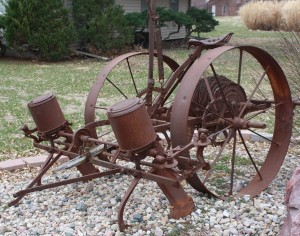 Ever watch the Sesame Street skit with Grover where he’s comparing near and far? It’s been a while since I’ve done then and now, so it was time to bring that back to the repertoire. I guess it’s an equal comparison: then (far) and now (near).
Ever watch the Sesame Street skit with Grover where he’s comparing near and far? It’s been a while since I’ve done then and now, so it was time to bring that back to the repertoire. I guess it’s an equal comparison: then (far) and now (near).
Then: This is a photo of a 2-row check row planter used in the 1920s and before. The mechanism was horse-drawn through the field as a wire was put down the row; and every 42 inches there was a knot in the wire and when it was tripped, the seeds were planted. They’d go back to the starting point, move the wire over by hand, and do it all over again down the next row.
Back then, they didn’t have mechanical weed control, so the 42-inch row/seed spacing allowed for a horse to fit through to cultivate. The result? A checkerboard or tic tac toe field pattern. And, this one was an improvement over the first of its kind as it has planter plates.
Now: Growers have abundant technology to farm faster, more acres, more hours, and more yield potential through the use of guidance systems and 24, 36 or 48-row planters. And that’s all in one shot: seed, fertilizer and crop protection.
Back then, if you farmed 80 acres you were a BIG operation. These days, 80 acres is just one small field.
Until we walk again …

